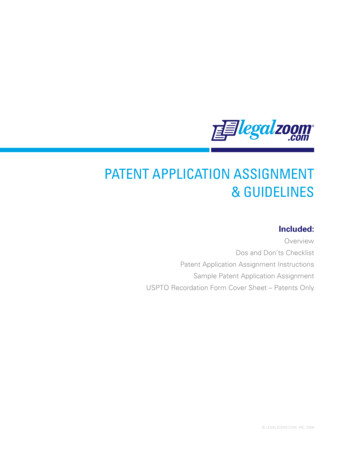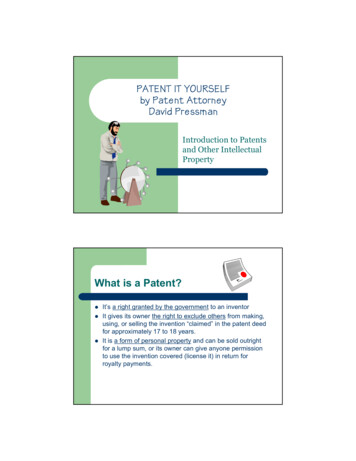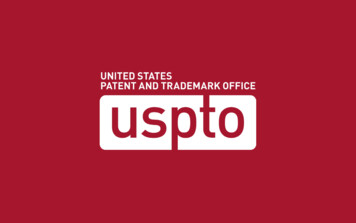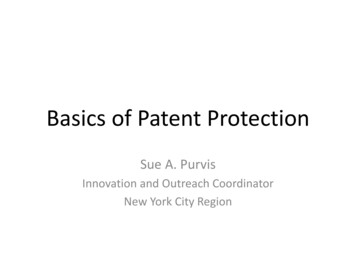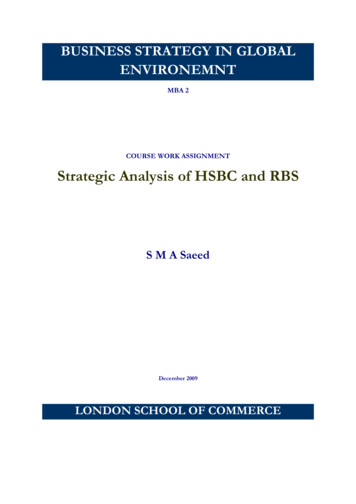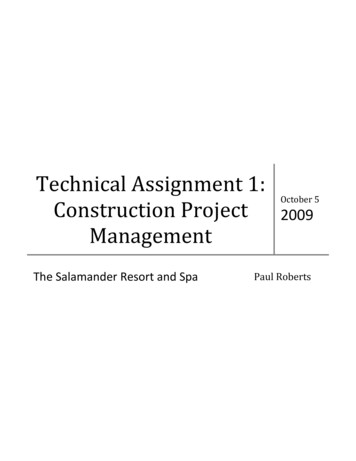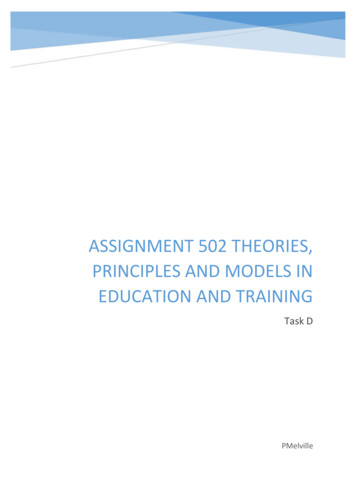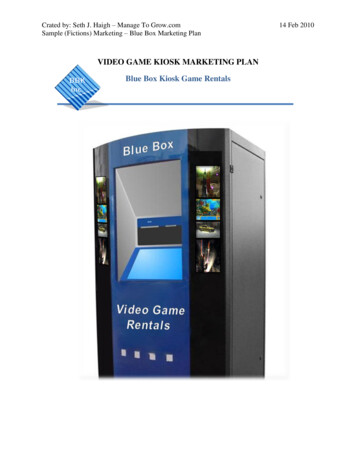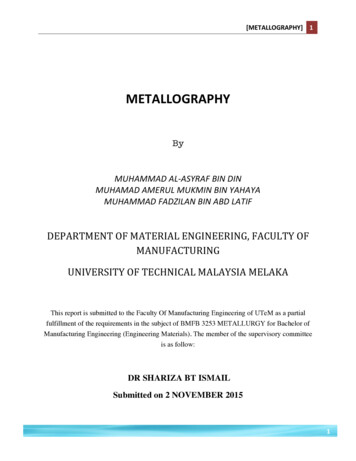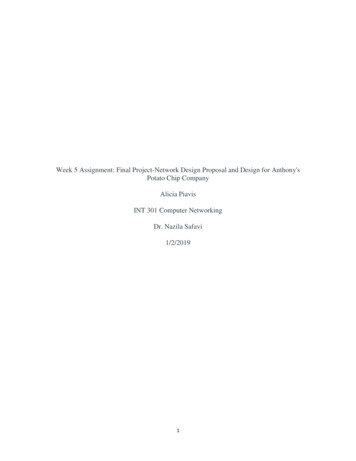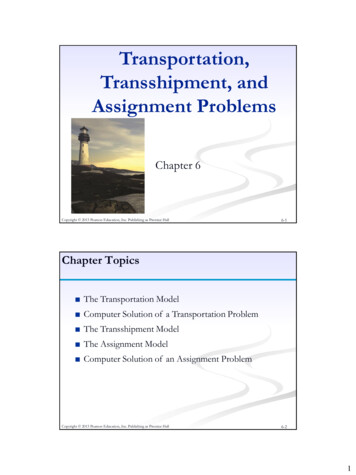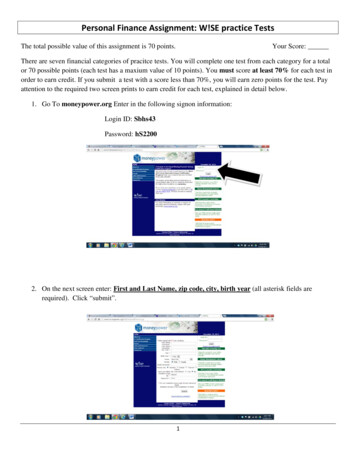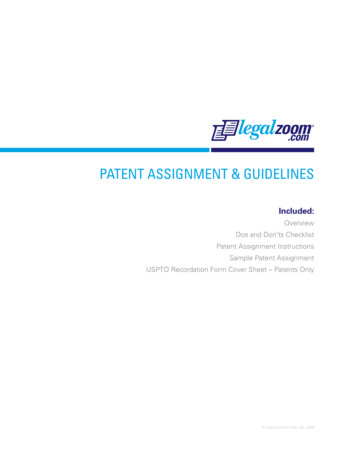
Transcription
PATENT ASSIGNMENT & GUIDELINESIncluded:OverviewDos and Don’ts ChecklistPatent Assignment InstructionsSample Patent AssignmentUSPTO Recordation Form Cover Sheet – Patents Only LEGALZOOM.COM, INC. 2008
1. OverviewA company’s ability to buy and sell property is essential to its long-term life and vitality. Although it doesnot take up physical space, too much intellectual property can burden a company, directing limited fundstowards maintaining registrations, defending against third-party claims, or creating and marketing afinal product. Selling unused or surplus intellectual property can have an immediate positive effect ona company’s finances, generating revenue and decreasing costs. When it does come time to grow abusiness, companies looking to purchase property (including patents and other inventions) to supporttheir growth must be sure that the seller does, in fact, have title to the desired items. A properly-draftedpatent assignment can help in both circumstances.A patent assignment is the transfer of an owner’s property rights in a given patent or patents, and anyapplications for such patents. These transfers may occur on their own or as parts of larger asset sales orpurchases. Patent assignment agreements provide both records of ownership and transfer and protectthe rights of all parties.If you follow the enclosed sample and guidelines, you will have a written acknowledgment of the rightsand responsibilities being transferred as part of your sale. This will provide essential documentation ofownership and liability obligations and you will be well on your way to establishing a clear record of titlefor all of your patents.2. Dos & Don’ts ChecklistA patent is a set of exclusive rights in an invention given by the government to its inventor for alimited period of time. Essentially, in exchange for the inventor’s agreement to make his or herinvention public and allow others to examine and build on that work, the government provides theinventor with a short-term monopoly for his or her creation. In other words, he or she is the onlyperson who can make, use, or sell that invention.A patent assignment can take many forms. It can be the transfer of an individual’s entire interest toanother individual or company. It can also be the transfer of a specific part of that interest (e.g., halfinterest, quarter interest, etc.) or a transfer valid only in a designated area of the country. The exactform of the transfer is specific to the agreement of the parties.Licenses are different than assignments. The individual who receives license rights from the patentholder is not gaining ownership – rather, he or she is getting assurance from the patent holder thathe or she will not be sued for making, using, or selling the invention. The terms of the license willvary from agreement to agreement, and may address issues of royalties, production, or reversion. Ifyou are looking only to license your invention, and not to sell all or part of it, you should not use theenclosed document.A patent transfer is usually accomplished through a contract, like the written agreement formthat follows. However, after the parties have negotiated and signed their agreement, the transfermust be recorded with the U.S. Patent and Trademark Office (USPTO). The agreement will not beeffective if this registration is not made. Moreover, if the transfer is not recorded within three (3)PATENT ASSIGNMENT & GUIDELINES LEGALZOOM.COM, INC. 20081
months from the date of the assignment, there can be no later purchasers. In other words, thepatent is no longer sellable to a third party by the assignee if it is not recorded quickly and correctly.There is a 40 fee for recording each assignment of a patent or patent application. If you aresubmitting your transfer papers to the USPTO by mail, you should send them (together with acover sheet and the fee) to Mail Stop Assignment Recording Services, Director of the United StatesPatent and Trademark Office, P.O. Box 1450, Alexandria, VA 22313-1450. Note that if you submityour assignment by mail, you should not use the original, since the document will not be returnedto you. In addition, the copy you submit must be on paper that is “flexible, strong white, non-shiny,and durable.”Although you should feel free to adapt the document to suit your arrangement, you should alwaysindentify the patent(s) being assigned by their USPTO number and date, and include the name ofthe inventor and the invention’s title (as stated in the patent itself). This is a requirement of federallaw and failure to follow it could invalidate your assignment.The advantage of selling your invention or patent outright (and not simply licensing or attemptingto develop and market it yourself) is that you are guaranteed payment at the price you and thepurchaser have negotiated. On the other hand, that one-time payment is all that you will everreceive for your property. You will no longer have the right to control anyone else’s use of yourcreation. By using it yourself or offering a temporary license, you retain the potential for futureincome. However, such income is by no means certain, and your opportunities are paralleled byrisk. Before selling all of your rights in a patent or patent application, make sure this is the best (andmost lucrative) approach for you and your company.Do not enter into an agreement without completing your due diligence. If you are purchasing apatent, conduct searches with the USPTO and online directories to make sure the seller actually hascomplete and unique rights in the offered property. Has an application already been filed by anotherperson or company? What are the chances that this is a patentable item? Although your findingswill not provide guarantees, you may have protection as an “innocent purchaser” if disputes arise.You might also find critical information about the value of the patent. Consider hiring a professionalto help in your investigation. Comparing patents and applications often requires a specialized andtechnical understanding to know how useful and unique each one is.If you are selling an invention or patent, make sure you own it. Although this may seem obvious,ownership of intellectual property is sometimes not clear- cut. This may be the case if, for example,the invention was created as part of your employment or if it was simply sold or otherwisetransferred to somebody else. A thorough search of the USPTO website should be conductedbefore you attempt to sell your property.Both parties should review the assignment carefully to ensure that all relevant deal pointshave been included. It is better to be over-inclusive than under-inclusive. Do not assume that certainexpectations or terms are agreed to if they are not stated expressly on the document.Sign two copies of the assignment, one for you and one for the other party.PATENT ASSIGNMENT & GUIDELINES LEGALZOOM.COM, INC. 20082
It’s a good idea to have your assignment notarized. This will limit later challenges to the validity of aparty’s signature or of the transfer itself.If your agreement is complicated, do not use the enclosed form. Contact an attorney to help youdraft an assignment that will meet your specific needs.3. Patent Assignment InstructionsThe following provision-by-provision instructions will help you understand the terms of your assignment.The numbers and letters below (e.g., Section 1, Section 2(a), etc.) correspond to the provisions in theagreement. Please review the entire document before starting your step-by-step process. Introduction of Parties. Identifies the document as a patent assignment. Write in the date onwhich the agreement is signed. Identify the parties and, if applicable, what type of organization(s)they are. Note that each party is given a name (e.g., “Assignor”) that will be used throughout theagreement. The Assignor is the party that is giving (“assigning”) its ownership interest and theAssignee is the party receiving it. Recitals. The “whereas” clauses, referred to as recitals, define the world of the assignment andoffer key background information about the parties. In this agreement, the recitals include a simplestatement of the intent to transfer rights in the patent.Remember that the Assignor can transfer all or part of its interest in the Patents. If the entire propertyis being transferred, use the word “all.” If only part of an Invention or Patent is being transferred,specify the amount being assigned (e.g., one-half, one-quarter, etc.). Section 1: Assignment of Patents. This constitutes the assignment and acceptance of theassignment of the Patents and Inventions. Note that the property being assigned is not described inthe agreement itself. The Assignment references “Schedule 1,” and explains that the full descriptionis located on that schedule. Be as complete and clear as possible in your description of the propertybeing transferred. Section 2: Consideration. In most agreements, each party is expected to do something. Thisobligation may be to perform a service, transfer ownership of property, or pay money. In this case,the Assignee is giving money (sometimes called “consideration”) to receive the Assignor’s property.Enter the amount to be paid, and indicate how long the Assignee has to make that payment after theagreement is signed. Section 3: Authorization to Director. The Assignor’s authorization to issue any Patents in theAssignee’s name. In other words, this tells the head of the USPTO that the transfer is valid and thatownership is changing hands by virtue of the Assignment.The bracketed last sentence is only applicable if the assignment is being recorded before a patentapplication number has been issued by the USPTO. It allows this application number to be writtenin after the assignment is recorded. If the applications have already been filed, and there have beenapplication numbers issued, delete this bracketed sentence.PATENT ASSIGNMENT & GUIDELINES LEGALZOOM.COM, INC. 20083
Section 4: Assignor’s Representations and Warranties. The Assignor’s promises about theproperty being sold. More specifically, the Assignor is swearing that:4(a): it is the sole owner of the Inventions and the Patents. If there are other owners who are nottransferring their interests, use the bracketed phrase. This means that the only part being transferredis the Assignor’s part.4(b): it has not sold or transferred the Inventions and the Patents to any third party.4(c): has the authority to enter the agreement.4(d): does not believe that the Inventions and the Patents have been taken from any third partywithout authorization (e.g., a knowing copy of another company’s invention).4(e): does not know of any permissions that have to be obtained in order for the assignment to becompleted. In other words, once the agreement is signed, the assignment will be effective withoutanyone else’s input.4(f): the Patents weren’t created while the creator was employed by a third party. In many cases, ifan individual was employed by a company and came up with a product, the company will own thatproduct. This section offers assurance to the Assignee that there are no companies that will makethat claim about the Patents being sold.If you and the other Party want to include additional representations and warranties, you can do sohere. Section 5: Assignee’s Representations and Warranties. The Assignee’s promises about thetransaction. More specifically, the Assignee is swearing that it:5(a): has the authority to enter the agreement.5(b) has enough funds to pay for the assignment.If you and the other Party want to include additional representations and warranties, you can do sohere. Section 6: No Early Assignment. Prevents the Assignee from re-transferring the inventions orpatents, or using any of them as collateral for loans, until it has made complete payment of the moneydue under the agreement. Section 7: Documentation. The Assignor’s promise to help with any paperwork neededto complete an assignment (e.g., filing information about the assignment with the USPTO andtransferring document titles). The bracketed phrases make the additional promise that the Assignorwill help with transfer paperwork for filings outside of the country. If this is not relevant to youragreement, delete the bracketed phrases. Section 8: No Further Use of Inventions or Patents. Indicates that after the effective date ofthe agreement, the Assignor will stop using all of the inventions and patents being transferred and willnot challenge the Assignee’s use of those inventions or patents.PATENT ASSIGNMENT & GUIDELINES LEGALZOOM.COM, INC. 20084
Section 9: Indemnification. A description of each party’s future obligations, if the patent or anyapplication is found to infringe on a third party’s rights. There are two options provided, and you shouldchoose the one that best fits with your situation. In the first, the Assignor takes all responsibilityfor infringement, promising to pay all expenses and costs relating to the claim. In the second, theAssignor makes its responsibilities conditional, greatly limiting its obligations if a claim is brought.Select only one of these options, and delete the other. Section 10: Successors and Assigns. States that the Parties’ rights and obligations will bepassed on to successor organizations (if any), or organizations to which rights and obligations havebeen permissibly assigned. Section 11: No Implied Waiver. Explains that even if one Party allows the other to ignore breakan obligation under the agreement, it does not mean that Party waives any future rights to require theother to fulfill those (or any other) obligations. Section 12: Notice. Lists the addresses to which all official or legal correspondence should bedelivered. Write in a mailing address for both the Assignor and the Assignee. Section 13: Governing Law. Allows the parties to choose the state laws that will be used tointerpret the document. Note that this is not a venue provision. The included language will not impactwhere a potential claim can be brought. Write the applicable state law in the blank provided. Section 14: Counterparts / Electronic Signatures. The title of this provision soundscomplicated, but it is simple to explain: it says that even if the Parties sign the agreement in differentlocations, or use electronic devices to transmit signatures (e.g., fax machines or computers), allof the separate pieces will be considered part of the same agreement. In a modern world wheresigning parties are often not in the same city - much less the same room - this provision ensures thatbusiness can be transacted efficiently, without sacrificing the validity of the agreement as a whole. Section 15: Severability. Protects the terms of the agreement as a whole, even if one part is laterinvalidated. For example, if a state law is passed prohibiting choice-of-law clauses, it will not undo theentire agreement. Instead, only the section dealing with choice of law would be invalidated, leavingthe remainder of the assignment enforceable. Section 16: Entire Agreement. The Parties’ agreement that the document they’re signing is “theagreement” about the issues involved. Unfortunately, the inclusion of this provision will not prevent aParty from arguing that other enforceable promises exist, but it will provide you some protection fromthese claims. Section 17: Headings. Notes that the headings at the beginning of each section are meant toorganize the document, and should not be considered operational parts of the note. Schedule 1: List of Patents. In order for a patent assignment to be effective, the patents beingtransferred must be clearly identified. Be thorough in your description and attach any registrations ordrawings that you may have. If you do include drawings, reference the inclusion of those items in theschedule (e.g., “* See attached drawing”).PATENT ASSIGNMENT & GUIDELINES LEGALZOOM.COM, INC. 20085
Enter the patent registration number, and the name of all of the registered inventors of the patent(s)(even if they are not parties to this Assignment). If the assignment relates to a patent application,identify the application number (consisting of a series code and a serial number, e.g., 07/123,456). Ifthe assignment relates to a provisional patent application, or an application that is being filed at thesame time as (or after) the assignment, you must also provide the name of each inventor and the titleof the invention.DISCLAIMERLegalZoom is not a law firm. The information contained in the packet is general legal information and should not be construed as legaladvice to be applied to any specific factual situation. The use of the materials in this packet does not create or constitute an attorney-clientrelationship between the user of this form and LegalZoom, its employees or any other person associated with LegalZoom. Because the lawdiffers in each legal jurisdiction and may be interpreted or applied differently depending on your location or situation, you should not relyupon the materials provided in this packet without first consulting an attorney with respect to your specific situation.The materials in this packet are provided "As-Is," without warranty or condition of any kind whatsoever. LegalZoom does not warrant thematerials' quality, accuracy, timeliness, completeness, merchantability or fitness for use or purpose. To the maximum extent provided bylaw, LegalZoom, it agents and officers shall not be liable for any damages whatsoever (including compensatory, special, direct, incidental,indirect, consequential, punitive or any other damages) arising out of the use or the inability to use the materials provided in this packet.PATENT ASSIGNMENT & GUIDELINES LEGALZOOM.COM, INC. 20086
Form SamplePATENT ASSIGNMENT & GUIDELINES LEGALZOOM.COM, INC. 20087
Form PTO-1595 (Rev. 08/08)OMB No. 0651-0027 (exp. 9/30/2008)Doc Code:U.S. DEPARTMENT OF COMMERCEUnited States Patent and Trademark OfficeRECORDATION FORM COVER SHEETPATENTS ONLYTo the Director of the U.S. Patent and Trademark Office: Please record the attached documents or the new address(es) below.1. Name of conveying party(ies)2. Name and address of receiving party(ies)Name:Internal Address:Additional name(s) of conveying party(ies) attached?YesNoStreet Address:3. Nature of conveyance/Execution Date(s):Execution Date(s)AssignmentMergerSecurity AgreementChange of NameJoint Research AgreementCity:State:Government Interest AssignmentCountry: Zip:Executive Order 9424, Confirmatory LicenseOther4. Application or patent number(s):A. Patent Application No.(s)Additional name(s) & address(es) attached?YesNoThis document is being filed together with a new application.B. Patent No.(s)Additional numbers attached?5. Name and address to whom correspondenceconcerning document should be mailed:Name:YesNo6. Total number of applications and patentsinvolved:7. Total fee (37 CFR 1.21(h) & 3.41) Internal Address:Authorized to be charged to deposit accountStreet Address:EnclosedNone required (government interest not affecting title)City:8. Payment InformationState: Zip:Phone Number:Fax Number:Email Address:Deposit Account NumberAuthorized User Name9. Signature:SignatureName of Person SigningDateTotal number of pages including coversheet, attachments, and documents:Documents to be recorded (including cover sheet) should be faxed to (571) 273-0140, or mailed to:Mail Stop Assignment Recordation Services, Director of the USPTO, P.O.Box 1450, Alexandria, V.A. 22313-1450
Guidelines for Completing Patents Cover Sheets(PTO-1595)Cover Sheet information must be submitted with each document to be recorded. If the document to berecorded concerns both patents and trademarks separate patent and trademark cover sheets, including any attachedpages for continuing information, must accompany the document. All pages of the cover sheet should be numberedconsecutively, for example, if both a patent and trademark cover sheet is used, and information is continued on oneadditional page for both patents and trademarks, the pages of the cover sheet would be numbered from 1to 4.Item 1. Name of Conveying Party(ies).Enter the full name of the party(ies) conveying the interest. If there is insufficient space, enter a check markin the "Yes" box to indicate that additional information is attached. The name of the additional conveying party(ies)should be placed on an attached page clearly identified as a continuation of the information Item 1. Enter a check markin the "No" box, if no information is contained on an attached page. If the document to be recorded is a joint researchagreement, enter the name(s) of the party(ies) other than the owner of the patent or patent application as the conveyingparty(ies).Item 2. Name and Address of Receiving Party(ies).Enter the name and full address of the first party receiving the interest. If there is more than one partyreceiving the interest, enter a check mark in the "Yes" box to indicate that additional information is attached. Enter acheck mark in the "No" box, if no information is contained on an attached page. If the document to be recorded is ajoint research agreement, enter the name(s) of the patent or patent application owner(s) as the receiving party.Item 3. Nature of Conveyance/Execution Date(s).Enter the execution date(s) of the document. It is preferable to use the name of the month, or an abbreviationof that name, in order that confusion over dates is minimized. Place a check mark in the appropriate box describing thenature of the conveying document. If the "Other" box is checked, specify the nature of the conveyance.Item 4. Application Number(s) or Patent Number(s).Indicate the application number(s), and/or patent number(s) against which the document is to be recorded.National application numbers must include both the series code and a six-digit number (e.g., 07/123,456), andinternational application numbers must be complete (e.g., PCT/US91/12345).Enter a check mark in the appropriate box: "Yes" or "No " if additional numbers appear on attached pages.Be sure to identify numbers included on attached pages as the continuation of Item 4. Also enter a check mark if thisAssignment is being filed with a new application.Item 5. Name and Address of Party to whom correspondence concerning the document should bemailed. Enter the name and full address of the party to whom correspondence is to be mailed.Item 6. Total Applications and Patents involved.Enter the total number of applications and patents identified for recordation. Be sure to include allapplications and patents identified on the cover sheet and on additional pages.Block 7. Total Fee Enclosed.Enter the total fee enclosed or authorized to be charged. A fee is required for each application and patentagainst which the document is recorded.Item 8. Payment Information.Enter the deposit account number and authorized user name to authorize charges.Item 9. Signature.Enter the name of the person submitting the document. The submitter must sign and date the cover sheet.Enter the total number of pages including the cover sheet, attachments, and document.This collection of information is required by 35 USC 261 and 262 and 15 USC 1057 and 1060. The information is used by the public to submit (and bythe USPTO to process) patent and trademark assignment requests. After the USPTO records the information, the records for patent and trademarks,assignments, and other associated documents can be inspected by the public. To view documents recorded under secrecy orders or documents recordeddue to the interest of the federal government, a written authorization must be submitted. This collection is estimated to take 30 minutes to complete,including gathering, preparing, and submitting the form to the USPTO. Any comments on the amount of time you require to complete this form and/orsuggestions for reducing this burden, should be sent to the Manager of the Assignment Division, USPTO, P.O. Box 1450, Alexandria, VA 22313-1450.DO NOT SEND FEES OR COMPLETED FORMS TO THIS ADDRESS. SEND TO: Mail Stop Assignment Recordation Services, Director of theUSPTO, P.O. Box 1450, Alexandria, VA 22313-1450.
Privacy Act Statement for Patent Assignment Recordation Form Cover SheetThe Privacy Act of 1974 (P.L. 93-579) requires that you be given certain information inconnection with the above request for information. This collection of information is authorizedby 35 U.S.C. 1, 2, 261 and E.O. 9424. This information will primarily be used by the USPTOfor the recordation of assignments related to patents and patent applications. Submission of thisinformation is voluntary but is required in order for the USPTO to record the requestedassignment. If you do not provide the information required on the cover sheet, the assignmentwill not be recorded, and all documents will be returned to you.After the information is recorded, the records and associated documents can be inspected by thepublic and are not confidential, except for documents that are sealed under secrecy orders orrelated to unpublished patent applications. Assignment records relating to unpublished patentapplications are maintained in confidence in accordance with 35 U.S.C. 122. Records open tothe public are searched by users for the purpose of determining ownership for other propertyrights with respect to patents and trademarks.Routine uses of the information you provide may also include disclosure to appropriate Federal,state, local, or foreign agencies in support of their enforcement duties and statutory or regulatorymissions, including investigating potential violations of law or contract and awarding contractsor other benefits; to a court, magistrate, or administrative tribunal in the course of presentingevidence; to members of Congress responding to requests for assistance from their constituents;to the Office of Management and Budget in connection with the review of private relieflegislation; to the Department of Justice in connection with a Freedom of Information Actrequest; to a contractor in the performance of their duties; to the Office of PersonnelManagement for personnel studies; and to the General Services Administration (GSA) as part oftheir records management responsibilities under the authority of 44 U.S.C. 2904 and 2906. Suchdisclosure to GSA shall not be used to make determinations about individuals.
creation. By using it yourself or offering a temporary license, you retain the potential for future income. However, such income is by no means certain, and your opportunities are paralleled by risk. Before selling all of your rights in a patent or patent application, make sure this is th
